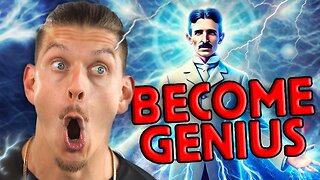Premium Only Content

Alan Hidalgo Educational Promotional Video Series: Between Two Worlds for ESL and ELD Students.
For more information on the Alan Hidalgo Team for educational consulting or to know more about the Between Two Worlds series for ELA and ESL students at the high school and college/university level, please visit our website Alanhidalgo.com or contact the Alan Hidalgo Team directly at education@alanhidalgo.com or alanhidalgocr@gmail.com
In this video, the focus is on the incredible impact of the Between Two Worlds Basic Edition on ESL/ELD students at the high school and college level (the Basic Edition is also very effective for Middle School students of grades 7-9). Much of this impact is due to the instant connection felt by students who are immigrants to the United States or first generation or second generation Americans to the novels of the BTW Anthology. However, all students find the positive and inclusive approach to multiculturalism, which is from the original and classical definition of being multicultural, which is to be cosmopolitan i.e. a person who is fluent and knowledgeable in many cultures and languages, and this is to be a desired and positive role model for all people. The life relevance and real human connection to the novels result in intrinsically motivated students who actually want to learn and grow by reading, analyzing, thinking, pondering, and responding in verbal and written form.
Many students at the middle school (grades 7-9), high school, and college level have found the ten novels that comprise the Between Two Worlds: A Multicultural and Multilingual Anthology to have had a deep and lasting positive impact on their lives. This is due to the life skills taught via the many high interest themes found in each novel (difficult family upbringing, navigating relationships as a young adult, gang violence, drugs, personal identity, MMA, culture, immigration, bullying, etc.) as well as the diverse cast of characters found in each novel (with settings ranging from California to Massachusetts to New Mexico to Texas to Indiana and origins ranging from immigration to the United States from Italy to Brazil and the Philippines to Nigeria and Mexico to Argentina and South Korea to Puerto Rico) and South America to the Middle East.
The BTW basic edition is comprised of the following:
-BTW Anthology: A Multicultural and Multilingual Anthology
--10 realistic novels, each with its own diverse cast of young adult characters that represent the many cultures and ethnicities found in the United States, and each with a unique central theme, a high interest plot, and character building life principles.
-BTW Student Workbook Basic Edition contains the following:
--Transcendent Path of Argumentation (a brief and simplified path to higher order thinking and greater awareness that moves beyond personal experience).
--Lesson 1 Vocabulary Development (from the 10 bold words found in each novel).
--Lesson 2: Reading Comprehension and Analysis (corresponding to each novel) divided into three parts: Plot Structure Analysis, Literary Devices Analysis, Main Character Analysis.
--Lesson 3: Essay Writing Composition (prompts that correspond to the novels as well as quickwrite and research prompts).
-Critical Reading Section
--5 reading principles to accurately interpret literature
-Critical Writing Section
--The four main essay types: Argument, Response to Literature, Expository, Narrative (biographical and reflective) with detailed explanation
--Scaffolding toward the final draft (graphic organizers, outlines, draft templates, and editor checklists)
-BTW Instructor Manual Basic Edition contains the following:
--Scope and Sequence: Example Lesson Plans for a Novel Unit
--Answer Keys for all 10 Novel Units
--Multiple Choice Assessments (50 Questions) for all 10 Novels
--Answer Keys for all 10 Multiple Choice Assessments
Students have found the BTW series to have greatly impacted their education as they have improved their ELA/ELD skills; namely, their ability to think critically and enter into higher order thinking, to apply moral reasoning, to cognitively analyze literature, and to write strong academic essay responses. This, in turn, naturally leads to improved grades in the classroom and increased test scores on standardized assessments.
-
 1:02
1:02
Music And Musings
3 years ago $0.01 earnedBrian Pottie Promotional Video
691 -
 5:09
5:09
BrandonRobertKersjes
3 years agoThe 616: A Grand Rapids Michigan Promotional Video
16 -
 1:00
1:00
3DubsMedia
4 years agoThe Lake Effect Series Promotion Video
135 -
 1:39
1:39
szpickij
4 years agoHodgepodge 1.0 Promotional Video
20 -
 33:49
33:49
Quite Frankly
19 hours agoThe Christmas Eve Midnight Telethon
68.7K7 -
 2:12:46
2:12:46
Price of Reason
19 hours agoAmber Heard BACKS Blake Lively Lawsuit Against Justin Baldoni! Is Disney CEO Bob Iger in TROUBLE?
24.4K11 -
 1:01:17
1:01:17
The StoneZONE with Roger Stone
13 hours agoChristmas Edition: Why the Panama Canal is Part of the America First Agenda | The StoneZONE
102K35 -
 18:12:15
18:12:15
LFA TV
1 day agoLFA TV CHRISTMAS EVE REPLAY
123K14 -
 13:32
13:32
Scammer Payback
15 hours agoChanging the Scammer's Desktop Background to his Location
1.21K2 -
 4:21
4:21
BIG NEM
17 hours agoNikola Tesla's Secret to Cultivating Creativity & Genius
851